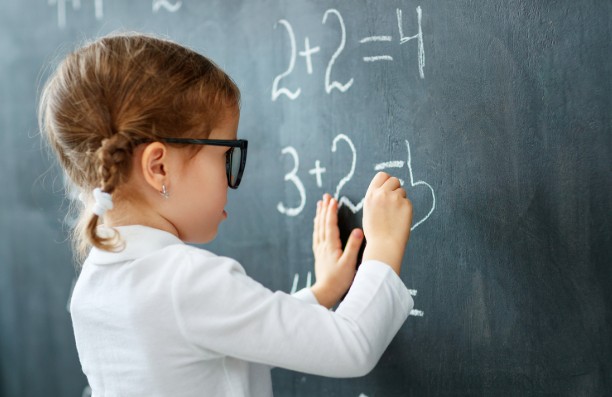How Should Kids in the U.S. Learn Math?
Reflections from a Parent and Educator
As a parent of three children—a high schooler, a middle schooler, and a younger elementary school child—and as someone who has worked in education for many years, I’ve seen firsthand some of the strengths and weaknesses of the U.S. education system, especially in mathematics. Watching my oldest child grow up, I now realize that fully relying on the school system for math instruction was a mistake. I wish I had supplemented schoolwork with more traditional practice and drills when she was young.
Looking Back: What I Experienced as a Parent
My oldest daughter attended a strong GATE (Gifted and Talented Education) program in elementary school. After second grade, I essentially “hands-off” her math education and trusted the school entirely. Her standardized test scores were always excellent—often in the 99th percentile—so I assumed she had a solid math foundation.
However, the first cracks appeared around 7th or 8th grade when she started IM2 (Integrated Math 2). She began to struggle. When I reviewed her incorrect answers, I realized something surprising: her logical thinking was strong, but her basic computation skills were weak.
This weakness became even more apparent in high school math and on the SAT. Many of her errors came from simple calculation mistakes—even with a calculator. She often understood the concepts and problem-solving strategies, but because her foundational skills were shaky, the final answers were wrong.
Reflecting on her elementary years, I now see that while she did plenty of problem-solving tasks and exploratory math at school, she rarely practiced repetitive, foundational drills. And that, in the long run, became a serious gap.
Where U.S. Math Education Falls Short
Based on my own children and the many students I’ve worked with, I believe there are several structural issues with how math is taught in the U.S.:
1. Too Much Focus on Problem Solving, Not Enough on Fluency
American math education heavily emphasizes “problem solving” and real-world applications. While this sounds ideal, practice and fluency often take a back seat.
A recent Bloomberg article* pointed out that many modern strategies—like discovery-based learning—can actually make math harder for students. These methods originate from constructivist theories from the early 20th century, which emphasize children “discovering” ideas through exploration rather than direct instruction.
2. Insufficient Repetition and Mastery of Basic Skills
Many U.S. students learn conceptual strategies like “grouping” or “decomposing numbers.” For example, to solve 29 + 15, children are taught to break it down into
20 + 9 + 10 + 5.
While this helps them understand why addition works, it doesn’t develop speed or accuracy.
I vividly remember my daughter using a “draw-a-grid” method to multiply numbers in third grade—literally drawing small boxes and counting them. No wonder she ran out of time on tests; she was spending minutes drawing grids instead of multiplying.
3. Underestimating the Value of Memorization and Automaticity
I strongly agree with the Bloomberg article’s argument that students should absolutely learn why math works, but after understanding, they need repeated practice to reach automaticity.
Automaticity—the ability to perform basic calculations quickly and accurately—is essential for higher-level math. Without this, students struggle with algebra, geometry, AP courses, and standardized exams.

My Adjusted Approach for My Younger Child
Fortunately, I have a younger child still in elementary school, so I’ve had the chance to adjust my approach. Looking back, this is how I would structure math learning from the start:
1. Lower Elementary (K–2)
Use Kumon or similar drill-based programs.
Focus on building strong number sense, basic operations, and mental math.
Allow some exploratory activities, but don’t let them replace practice.
2. Upper Elementary (3–4 Grade)
Introduce Singapore Math for strong conceptual understanding.
For advanced learners, add Beast Academy to develop problem-solving depth and creativity.
3. Middle School
Students with solid elementary foundations should be well-prepared for standard middle school math, AP pathways, and high SAT math scores.
Students with high math ability can progress to Art of Problem Solving (AoPS) and consider math competitions.
4. High School
Continue balancing conceptual learning with practice.
Even in advanced courses (AP Calculus, etc.), reinforce basic computation and algebra fluency.
For SAT preparation, specifically target speed, accuracy, and careless mistakes.
Why This Approach Works
The Bloomberg article argues that discovery-based learning—while well-intentioned—has unintentionally weakened foundational math skills for many American students. When children spend too much time exploring and not enough time practicing, they don’t develop the fluency needed for higher-level math or timed exams.
My recommendations—understanding + repetition—are a direct response to that issue. Children should absolutely learn the why, but they must also drill the how until it becomes automatic. This combination leads to long-term success.
Final Thoughts for Parents and Educators
For Parents
Don’t fully “hand off” math education to the school, especially in elementary grades. Even if your child performs well on tests, supplementing with structured practice is vital.
For Teachers
It’s possible to keep problem-solving and conceptual lessons while also giving students enough practice to build fluency. These two approaches don’t conflict—they complement each other.
For Schools and Policymakers
Support math instruction that balances conceptual understanding with skill mastery. Students need both in order to succeed.
Conclusion
Through my children’s journeys and my work with many students, I’ve realized that math success requires more than creativity and problem-solving. It also requires strong, automatic foundational skills. The U.S. education system tends to underemphasize this, which leads to struggles later in middle school, high school, and standardized testing.
If we want children to thrive in math long-term, we must ensure they not only understand math—but also practice it until they truly master it.
* https://www.bloomberg.com/opinion/articles/2025-11-17/math-instruction-isn-t-adding-up-to-success-in-us-schools?embedded-checkout=true